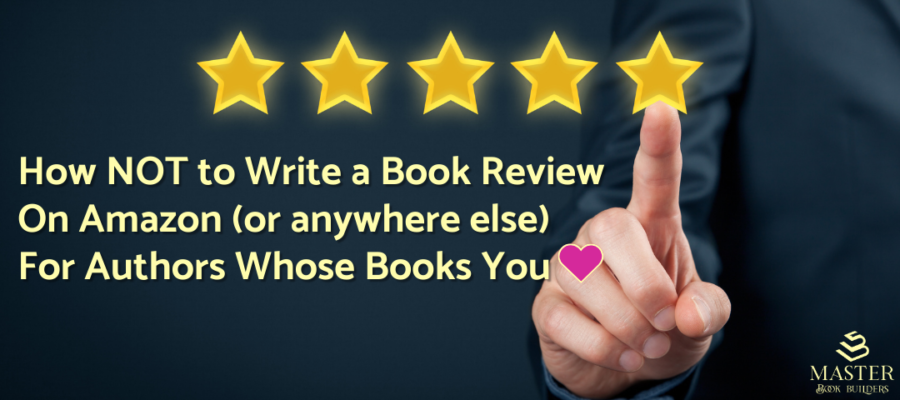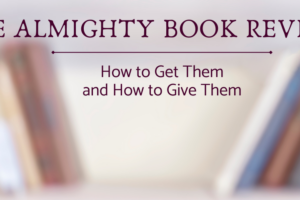How NOT to Write a Book Review On Amazon (or anywhere else) For Authors Whose Books You 💗
Book reviews, much like everything else in today’s techno-world, have changed.
You will still see the standard kind of review from Kirkus Reviews or Publishers Weekly or other publications that do book reviews. These book reviews are written to give the public a peek inside the book and to offer insight on what’s good about the book and often advice on what the author could have done a little better.
That’s the standard. You start with something good, you explain your reasoning and offer your insight and opinion, and you finish with a comment about something that could be improved.
For instance:
“I enjoyed reading this book because it reminded me of my grandmother.” Then, “I remember sitting with Grammy, as we called her, and watching her knit, just like the main character in this book.” Finally, “The book gets five stars because it captivated me and kept me engaged all afternoon. But I wish the author had been more descriptive in setting scenes. I like a lot of description!”
Today, when someone writes a book review, be it on Amazon or Goodreads, any of the sites in the link above, or on their blog, the standard formula is not followed as much. I, myself, have moved away from it.
Rather than adhere to a strict formula as I shared above, you can just write from the heart. Tell the author and anyone who lands on the author’s page, exactly why you liked the book. (What to do if you didn’t like the book is covered below – read on.)
Let’s Discuss the Mighty Book Review 💪
I am going to assume that you have books you have read and like. Perhaps you even loved one or two of them. Perhaps your life was changed by a book. Perhaps you have several books by the same author.
I am now going to assume that you won’t mind going to Amazon and writing a review for said author or said books.
This involves going to Amazon.com – easy-peasy so far – and searching for the book you wish to write about. Once on the page, you scroll down past the “based on your recent views” suggestions, past the product details and about the author, until you come to the review section.
There will be a button that says, “Write a customer review.” Click it.

Now you will be able to share an image of yourself with the book. Yes, I am asking you to do that. Amazon prefers it. Or, you may share a video about the book. But you still have to WRITE the review. Spider bots cannot read videos or images. They need text.
Remember that you’re writing this review to benefit the author, not yourself. Reviews give the author social proof. And, according to SearchEngineland:
“Amazon’s algorithm considers reviews when ranking products in search results.
“Products with more and better reviews often appear higher in search results, making them more visible to potential customers.”
Yes, I hear someone asking about Verified Reviews. One way to be verified is to have purchased the book yourself. (Yes, Amazon knows if you did or not). Another way is to be a frequent reviewer of products, books or otherwise.
I consistently review products on Amazon so when I do a book review, they know I am a qualified reviewer. Whether I purchased the book or it was given to me as a gift does not matter.
Yes, you can write reviews of products you did not purchase so if your book was a gift, don’t let that hold you back.
Before you start your review, give the book a star rating. Please be kind. IF the book is truly so bad it cannot garner 3 or more stars, consider not leaving a review. Why waste your time and upset the author? Others may feel the same and a lack of reviews will accomplish what your negative review would have.
How NOT to Write a Book Review ❌
This is not a place to get promotional. It’s not about you. It’s about the book. Write down 3 -5 facts about the book that you can talk about. Think about how the book made you feel. And why. I always include at least one quote or fact from the book, sometimes to prove I read the book but also to show the author I know what I’m talking about.
Don’t write long sentences without breaks. Don’t crunch your message into a long paragraph that could be two paragraphs. White space counts! Bullet points and bolded letters or italics to highlight key points in the text are useful for other people who want to read your review. As mentioned above, please use images and/or video to make the review pop.
Don’t ramble. “I really liked this book because it was easy to read and it had great chapter titles. I was wondering if the author thought up those titles or if he had help. I wish someone I know would write a book and ask me about the title. That would be so cool!” That is not helpful. The author has no way to determine what you’re talking about if you ramble like that. That is not as much about his book as it is about you wanting to be part of a book’s creation.
Don’t review without preparing! It helps to look at the book’s description to determine keywords that might help the author be found on Amazon’s huge database. Authors should be using keywords in their descriptions and if you can insert one or two into your review, excellent.
Don’t rush your review. Take your time. Remember to to mention the author’s name and the title of the book, at least once.
Don’t write a lame headline: “I enjoyed this book.” Be more specific.
Write something interesting:
This book made me rethink how I write content for my newsletter.
This book had me hooked from the first paragraph.
This book taught me how to meditate better.
My daily routine was transformed by this book.
I never realized building a house was just like writing a book.
Those are just some examples. Write your own, in your own words.
Next, write at least two paragraphs, please. Give the spider bots something to chew on. One or two sentences is just not enough. Amazon won’t even give them a glance. Make the content count!
Don’t Do That. 👆 Do This. 👇



Those are a few examples of good Amazon reviews. Learn from them. Be the reader who supports her authors by making it a habit to review their books for them.
If you need help with the formatting, if having a template is of use to you, go to Book Riot and download the one the suits you. As mentioned above, I just write from the heart. But I totally understand and approve of those who use a template.
Want to see examples of bad reviews? Hop over to this link where Make Use Of showcases some truly awful book reviews. Make sure you never get on a list like this.
p.s. this post was inspired by a LinkedIn post (do connect and follow me on LinkedIn) where an author was lamenting a poor review that was all about the torn box the book arrived in. Seriously. Instead of giving the author the benefit of reading the book and writing an honest opinion, this reader complained about Amazon.
DO NOT COMPLAIN ABOUT AMAZON IN YOUR REVIEW! Do not fault the author if the cover design is off center. Do not act as if it’s the author’s fault if the box is torn, or the introduction is cut off somehow. The author has no control over these issues. Well, if they are Indie published authors, they have a little. If you politely let them know the cover is wonky, they can check with others and see if they need to reload the cover. If you politely tell them the interior pages have errors in how the text is laid out, and if they are Indie authors, they can fix that.
Your review should be about the content in the book. Yes, you can remark on the beautiful cover, if you so desire. You can compliment the author on his interior design, if you so desire. But do not rant in your review about issues that have nothing to do with your reading of the book.
Please and thank you.
And if you truly want to see some awful reviews, go here. That’s all I will say about that!
Need more book reviews? Ever thought of a blogger book tour? DM me on LinkedIn to learn more.






1 Comment
Leave your reply.